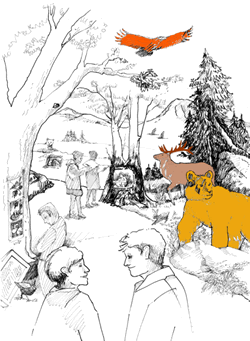




Exhibits

NCNHM will feature two permanent exhibits (Ages of Northern California and Worlds of Northern California) and every year have a new traveling exhibit. The traveling exhibit will be on loan from one of the major U.S. natural history museums.
NCNHM’s permanent exhibits will incorporate the latest techniques in museum exhibitry to ensure an enjoyable and rich learning experience for visitors. Our exhibits will be engage the visitor and make them an active part of the exhibit experience. These elements can be as simple as placing a child’s hand into the footprint of a dinosaur or making a rubbing of the footprint of a great blue heron. Or they may be as sophisticated as using a computer game to simulate the population growth of a colony of bacteria or a school of shad. In every instance, visitors will use their minds and hands to interact with the exhibits.
Rather than the traditional natural history dioramas, consisting of a replication of a habitat in a box, behind a piece of glass, our exhibits will feature dioramas using the new concept of immersion design, in which the diorama is opened up and the visitor literally walks through the exhibit. Walkways wind through the middle of a habitat, with trees and animals on either side and the sounds of the habitat all around. Reproductions of animals can be touched. Touch-screen monitors built into the rocks and trees enable the visitor to call up videos and computer animations to learn more about the plants and animals and geology of the habitat.

In short, in the NCNHM the visitor will be part of the exhibit, actively participating in a learning experience that is both fun and informative.
Ages of Northern California
Ages of Northern California will examine the region’s past and compare it with our present. The exhibit’s three components will be rich in interactive components, giving visitors the opportunity to become engaged with the exhibits and actively learn while meeting challenges and solving puzzles.
The emphasis in this exhibit will be on experiencing the exhibit, as the visitor walks through “Immersion Dioramas” placing the visitor in the middle of the exhibit (rather than viewing it through a window fronting a box). The sights and sounds of the exhibit will surround the visitor on all sides. Signs will be few and discrete. To learn more about any aspect of the exhibit, visitors will interact with touchscreen monitors embedded in the exhibit to call up short videos on a wide range of subjects.

The Glen and Virginia Toney Mesozoic Age of Dinosaurs will feature an extensive collection of dinosaur and reptile fossils from the Mesozoic era, including the first dinosaur fossil found in Northern California. Northern California’s premier fossil hunter, Professor Richard Hilton, will assemble and curate this exciting display.
The Garey and Barbara Weibel Pleistocene Ice Age of Giant Mammals will feature fossils of mammoths, mastodons, saber-toothed cats, dire wolves, camels, and giant ground sloths in Northern California during the Pleistocene Era of the last Ice Age. Again, Professor Hilton will assemble and curate this stunning collection.
The Gary and Judy Sitton Current Age of Conservation will highlight the reptiles, mammals, and birds currently in Northern California, comparing it with the Mesozoic and Pleistocene collections. Teaching us how much we have, and how much we’ve lost, inspires us to responsible stewardship and conservation of our heritage.
Worlds of Northern California
Worlds of Northern California, housed in Cornyn-Moore Hall, will lead the visitor on a walk through the region’s four main habitats. A winding pathway begins at the Coast, then makes its way to the Valley, the Foothills, and ends in the High Mountains. Again, the exhibit is an immersion diorama, rich in interactive elements, featuring touchscreen monitors.
The Coast features the world-famous Redwood groves, and the exotic animals inhabiting them: Roosevelt elk, banana slugs, and marbled murrelets are on either side of the path. Offshore, gray whales cruise and elephant seals and harbor seals dive.
The Valley shows this habitat in the 1850’s, when marshes and wetlands dominated most of the year, teeming with ducks and geese, cranes, tule elk, and otters. Grizzlies and pronghorns graze the grasslands beside the path.
The Foothills are vast rolling hills of native perennial grasses dotted with blue oak and live oak woodlands, with acorn woodpeckers and Beechey ground squirrels keeping out of reach of the hawks and eagles, coyotes and mountain lions around you. We feature the native-American Ishi’s last campsite in a foothill canyon, showing him gathering the bounty of Deer Creek’s plentiful trout and salmon.
The High Mountains examine our region’s three mountain systems: the granitic Sierra Nevadas, the volcanic Cascades, and the eclectic Siskiyou Range, hosting the continent’s greatest diversity of coniferous trees. Wolverines and pine martens, Clark’s nutcrackers and many types of woodpeckers are depicted amidst the conifers and the snowy ridges beside the path.